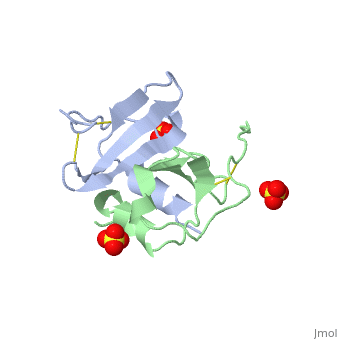C-X-C motif chemokine
From Proteopedia
| Line 43: | Line 43: | ||
**[[2k03]], [[2k04]], [[2k05]] - hSDF1α (mutant)+ hCXCR4 N-terminal (mutant)<br /> | **[[2k03]], [[2k04]], [[2k05]] - hSDF1α (mutant)+ hCXCR4 N-terminal (mutant)<br /> | ||
**[[4lmq]] - hSDF1α + immunoghlobulin heavy chain<br /> | **[[4lmq]] - hSDF1α + immunoghlobulin heavy chain<br /> | ||
| + | |||
| + | *CXCL13 | ||
| + | |||
| + | **[[4zai]] – hCXCL <br /> | ||
| + | **[[5cba]], [[5cbe]] – hCXCL + antibody<br /> | ||
*CXCL14 | *CXCL14 | ||
Revision as of 08:17, 12 April 2017
| |||||||||
| CXCL12α dimer complex with sulfate, 1qg7 | |||||||||
|---|---|---|---|---|---|---|---|---|---|
| Ligands: | |||||||||
| |||||||||
| |||||||||
| Resources: | FirstGlance, OCA, PDBsum, RCSB | ||||||||
| Coordinates: | save as pdb, mmCIF, xml | ||||||||
C-X-C motif chemokine (CXCL) are small chemokines which contain the sequence Cys-X-Cys at their C-terminal. The CXCL are subdivided into 2 groups: ELR positive (containing Glu-Leu-Arg preceding the C-X-C) and ELR negative.[1]
• CXCL2 or MIP-2 or imacrophage inflammatory protein 2 acts as chemotactic for polymorphonuclear leukocytes and hematopoietic stem cells.
• CXCL10 or IP-10 or interferon γ-induced protein 10 acts as chemoattractant for monocytes, T cells NK cells and dendritic cells. CXCL10 binds to the cell surface receptor CXCR3.
• CXCL11 or IP-9 or interferon γ-induced protein 9 acts as chemotactic for activated T cells.
• CXCL12 or Stromal-Derived-Factor-1 (SDF1) has a role in angiogenesis, tumor metastasis and the migration of cells from the liver to the bone marrow during embryogenesis.
• CXCL14 or BRAK acts as chemotactic for monocytes and inhibits angiogenesis.
3D Structures of C-X-C motif chemokine
Updated on 12-April-2017


